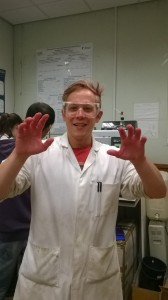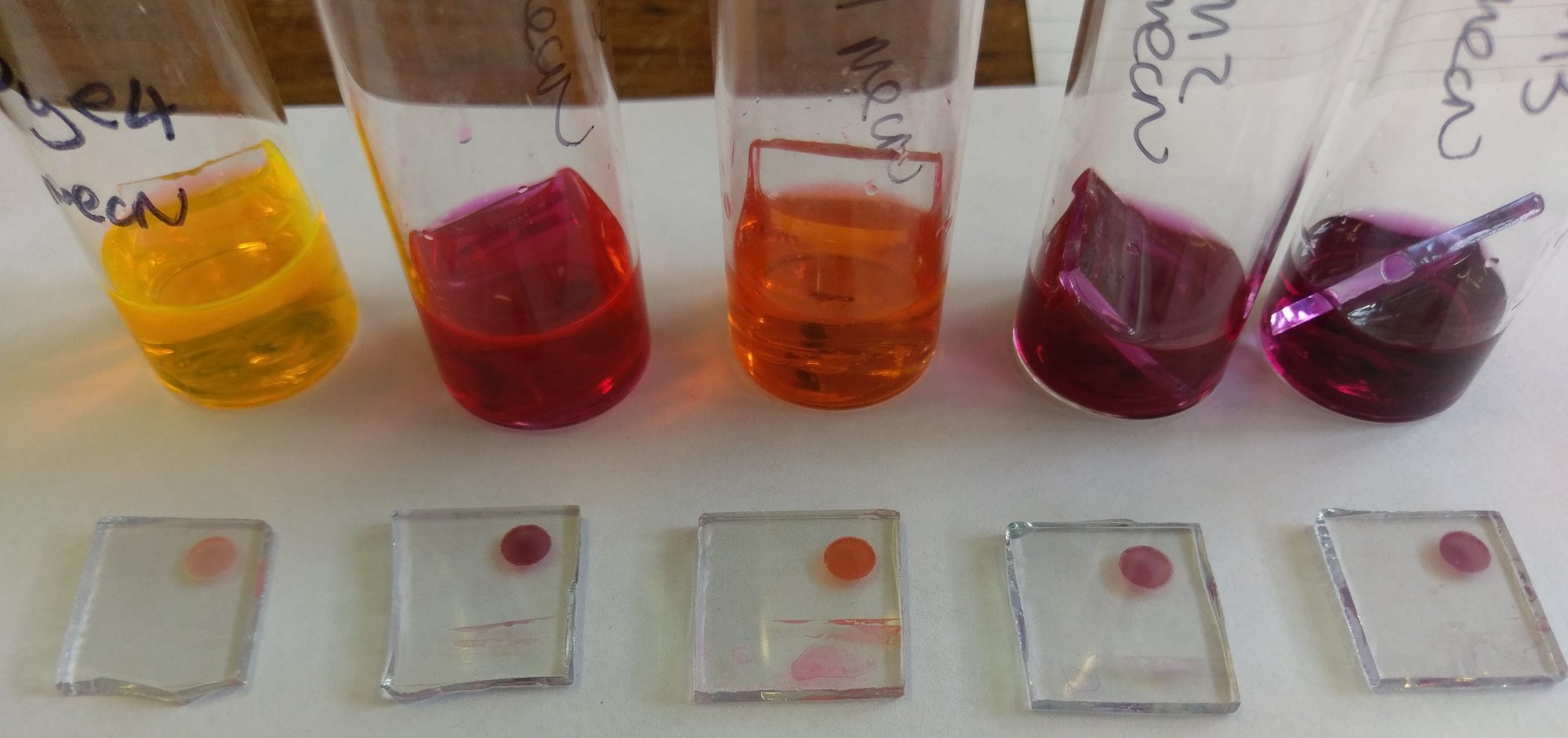 It’s Dr Wood’s last day with us today. The first PhD student to graduate from the group is going on to work with Big Solar in Sunderland. We wish Chris all the best for the future!
It’s Dr Wood’s last day with us today. The first PhD student to graduate from the group is going on to work with Big Solar in Sunderland. We wish Chris all the best for the future!
Gordon Research Conference Renewable Energy: Solar Fuels – Nils Poldme
I had the opportunity to attend the Gordon Research Conference, Renewable Energy: Solar Fuels, which was held from 28th of February to 4th of March in Renaissance Tuscany Il Ciocco situated in Lucca, Barga, Italy, and I would like to share my experiences and impressions gained during this week filled with latest scientific advances and knowledge exchange.
The conference had a multidisciplinary nature but an overarching goal: to discuss the latest science on how to convert sunlight into chemical energy. Speakers with different backgrounds approached the problems in this field from different angles. The talks and discussions covered a range of different fields ranging from semiconductor materials and molecular catalysis to computational modelling of the systems and biochemical approaches. My work as a postgraduate researcher is focused on the research of new photocathode materials for efficient photoelectrochemical water splitting and development of the cost efficient photoelectrochemical flow cell using these materials, therefore the talks covering topics like new materials and system design were most interesting to me. In addition, several other speakers with a bit different topics proved to be very fascinating as well and gave a lot of new ideas on how to approach some of the challenges I am experiencing in my project.
In terms of new materials relevant to my project, the most fascinating talks on my opinion were given by Greta Patzke from University of Zurich, Kyoung-Shin Choi from University of Wisconsin-Madison and Guido Mul from University of Twente. Greta Patzke’s talk was on cobalt-based water oxidation catalysts and interactions between molecules and solids and I was especially interested of some of the aspects of inorganic catalysts mentioned in her talk. Most interesting part of Kyoung-Shin Choi’s talk for me was the discussion on new electrochemical synthesis methods which would be an interesting approach to try also in my project. Guido Mul was focusing in his talk on new catalysts on fuel generation. One of the materials he mentioned in his talk is also the one I am working with (NiOOH) and therefore I was able to obtain some further understanding of the processes related to the use of this material.
The 2nd Molecules and Materials for Artificial Photosynthesis conference – Libby Gibson
The 2nd Molecules and Materials for Artificial Photosynthesis conference was held form the 25-28th February 2016 in Cancun, Mexico. The meeting was chaired by Pof. Jin Zhang and Prof Antoni Llobet and there were 66 participants altogether. I gave a 25 minute invited talk on the Saturday morning entitles “Dye-sensitized photocathodes for solar fuel devices”. Most of the talks were focused on the challenge of Water-splitting to generate hydrogen with some presentations on CO2 reduction and methanol oxidation. The following is a selection of the themes of the conference and highlights for each:
Devices
On the first day, the theme was “Water-Splitting: materials and Fundamental Issues” and the opening lecture was by Professor Kazunari Domen of The University of Tokyo. Prof Domen presented many videos showing hydrogen and oxygen evolution from the water splitting devices made in his laboratory. A 4 x 4 cm screen printed panel was a particular highlight and an inspiring beginning to the conference. Other devices were presented by e.g. Mario Lanza (Ni-coated photoanodes based on a Ti foil substrate, Si absorber protected by SiO2 and coated with a Ni catalyst). In general it was shown that the particle size (<5 nm) is important for catalyst activity and oxide layers (TiO2, SiO2) are key to stability. Prashant Kamat highlighted the merits of using PV+ electrolysis (12.3 % conversion efficiency), particularly by taking advantage of new perovskite absorbers.
Theory and Mechanisms
James Muckerman presented a theoretical approach, including a proposed mechanism for water splitting over GaN. Several talks discussed the surface chemistry of metal oxides (Aleksandra Vojdovic, Qinfeng Ge, Bart Bartlett CuWO4, Curtis Berlinguette NiO). Much of this was theory based but James Durrant and representatives from his group showed how the intermediates at the surface can be monitored during catalysis using photoinduced absorption spectroscopy. James McCusker gave an inspiring talk on controlling the photophysics of first row transition metal (e.g. Fe)-based photosensitizers by tuning the geometry of the ligands and adding substituents (e.g. t-Bu) to block vibrational relaxation. I discussed this technique which he called vibronic phasing in detail with him as it should be very useful for my own research. Likewise the talk by Charles Schuttenmaer on in-situ THz spectroscopy of WO3 devices was impressive. The group have developed a patterned grid structure that allows sufficient transparency in the transparent conductive substrate for transmittance measurements to be made on the charge-carriers.
Nanotechnology
Inspiring talks regarding the synthesis of nanostructured materials were given by Lionel Vyssieres (spontaneous and precise deposition of a molecular catalyst on the tip of “nano pyramids” driven by a photoinduced electric field enhancement); Zetian Mi (Ga(In)N nanowires which have the ideal electronic level alignment for water splitting without the need for sacrificial agents); Shihe Yang (solution processed nanowires, perovskite nanowires, FeNi, FeNiS double layer structures);
Molecular materials
Tong Xu presented a hybrid approach, based on Pt complexes and a Ru(bpy)32+ dye in MOF 253. Richard Finke described the challenges of proving the identity of the catalyst. Several talks described the role of coordinating ligands in the catalytic mechanism (Douglas Grotjan and Elizabeth Papish, pH responsive ligands; Jozsef Pap, Elisabeth Romero, Xuan Zhao, pendant bases; Ken Sakai Ni pyrazine dithiolene ligands; Marc Robert porphyrins & Etsuko Fujita, OH-functionalised bipyridines for CO2 reduction; Craig Richmond, role of axial ligands in Ru(bda)L2 water oxidation catalysts) and this seems to be the general trend in the field.
Catalysts
The most popular catalysts currently seem to be RhCr2O3 and Ni for hydrogen evolution, CoPi, NiCeOx and NiO for oxygen evolution. Llobet’s dinuclear Ru and Cu complexes lead the way in molecular photocatalysts.
4th UK Solar Fuels Symposium – Fiona Black
The 4th UK Solar Fuels Symposium took place on the 22nd January 2016 at St John’s College, University of Cambridge. The symposium included invited speakers Professor Edman Tsang, Dr Akshay Rao, Professor Gregory Wildgoose and Dr Kylie Vincent, in addition to talks by early career researchers and academics. The talks covered a wide range of topics, including new and interesting materials for water splitting solar fuels applications.
Professor Edman Tsang gave an interesting talk on MoS2 and carbon nitride thin layers for photocatalytically converting water to hydrogen, and the importance of the position of a chemisorbed dye for effective electron transfer. Dr Jesper Jacobsson from EPFL then gave a thought-provoking talk based on cell design for hydrogen production and the terminology used in this area. The final talk of the morning session was by Madeleine Morris from Imperial College London. She introduced an interesting concept of using the internal electric field of ferroelectric materials to reduce recombination and increase charge lifetimes. Madeleine presented kinetic traces of a number of materials including the ferroelectric barium titanate which showed increased charge lifetimes relative to other materials.
Dr Colin Lockwood followed a poster session with a change of topic, focussing on exploiting the processes in certain bacteria to drive photoreduction. Dr Katherine Orchard from the University of Cambridge gave an interesting talk showing that varying the extent of capping of quantum dots affects the binding of a nickel catalyst, and in turn dictates selectivity for CO production over hydrogen production. Invited speaker Dr Akshay Rao presented the application of electroabsorption spectroscopy as a way of measuring the distance which charges move through materials.
In the first talk of the session after lunch, invited speaker Professor Gregory Wildgoose presented a method of activating hydrogen using frustrated Lewis pairs, resulting in a large decrease in the overpotential needed for hydrogen oxidation. The talk introduced a useful way of storing hydrogen. The remaining two talks of the session were given by Dr Reiner Sebastian Sprick who introduced charge-transfer processes using conjugated polymers, which exhibited tuneable absorption properties based on the ratio of different monomers, and Yiou Wang from University College London who showed the benefits of graphitic carbon nitride in producing CO from methane, O2 and CO2.
The final afternoon session began with Professor Anthony Harriman from Newcastle University, who posed the problem of directing multiple electrons generated from solar energy to the same site at the same time to split water. Following this, Dr Graham Newton introduced polyoxometalates which include a ruthenium sensitiser as electron-transport materials. The final talk of the symposium was given by inviter speaker Kylie Vincent, who gave an interesting talk relating to understanding the mechanism of NiFe hydrogenases using infrared spectroelectrochemical techniques.
Posters were presented throughout the day, providing an opportunity to discuss ideas which were presented in the talks with researchers and academics.
Welcome!
Here you can find out about our research activities and how we are developing devices that convert sunlight to electricity or fuel.
If you are interested in joining our team the following positions are open:
SAgE Doctoral Training Awards Scheme (2016 Entry)
http://www.ncl.ac.uk/sage/study/postgrad/dta/
The following projects are available:
http://www.ncl.ac.uk/sage/study/postgrad/dta/documents/2016-Gibson-36.pdf
http://www.ncl.ac.uk/sage/study/postgrad/dta/documents/2016-Errington-136.pdf
http://www.ncl.ac.uk/sage/study/postgrad/dta/documents/2016-Healy-100.pdf
http://www.ncl.ac.uk/sage/study/postgrad/dta/documents/2016-Probert-118.pdf
